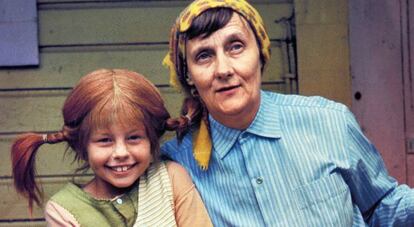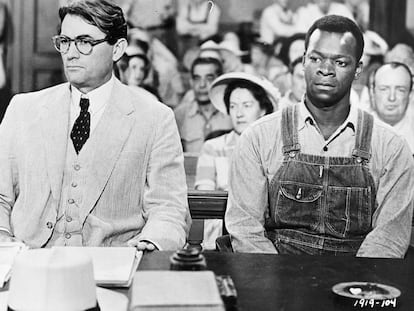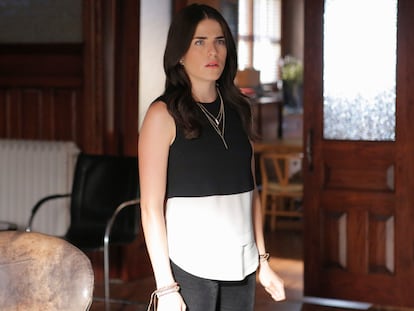Progressive gender-wise, yet racially dated: How well has Pippi Longstocking aged?
The iconic series from the 1970s still feels fresh enough to capture the interest of the younger generations; however, some tweaks have been necessary to adapt it to the sensibilities of today

She comes into town whistling a tune, riding a spotted horse, menacing and irresistible at the same time. She’s a nine-year-old girl with red hair and a little monkey on her shoulder, but she struts like an outlaw: fiercely independent, totally indomitable, with her own code of justice. It’s the irreverent Pippi Longstocking, part of the childhood imagination of several generations of parents who today are more than happy to introduce her to their kids as proof that there were also cool things when they were little. But, how well has she aged?
“She’s cool because she does whatever she wants.” “She’s a rebel.” Lupe and Celia, seven and ten years old, crack up when the little Swede girl breaks eggs with her head or skips school. They like that “she’s not corny,” that she “gets sassy with the bad guys” and that “she’s strong and she’s bonkers.” “What’s amazing is that Pippi used to question what a 1940s girl should be like, but she’s still doing it now,” says Elina Druker, a professor specializing in children’s literature at Stockholm University, where she teaches a popular course on author Astrid Lindgren, who in 1969 scripted the series based on her own books, written in the middle of World War II and imbued with a deep anti-authoritarian spirit. Lindgren was a middle-class housewife and a secretary by training who wrote her first novel to distract her daughter. And just like Pippi, she did exactly what she wanted.
The success (and controversy) of the books was immediate, and in 1949 a first film was shot – which the author hated. “Screenwriter Per Gunvall decided to add a romantic plot to make it more appealing to adult audiences,” explains Annika Lindgren, Astrid’s granddaughter and a director at the company that manages the rights to her work. “It was a huge disappointment for her, and it didn’t work out with the audience either. From that moment on, she decided to write all the adaptations herself.”
“More than a little girl, Pippi is a superhero which we would now call gender fluid,” says Druker. “She laughs at gender roles, social norms, etiquette, bureaucracy, the educational system, authority, normative beauty...” When she sees a sign that reads “Do you suffer from freckles?” hanging at a drugstore to sell ointments, she enters to say no: she doesn’t suffer from freckles. She loves hers. “I can take care of myself,” says the strongest girl in the world, who claims to like policemen less than sour compote with flies. “In that sense she’s incredibly current, she’s still weird, annoying and provocative; she still works,” says Druker, “and of course, she’s still incredibly cool.”
The art direction and Swedish minimalism help. Pippi’s eccentric wardrobe, but also Annika’s raincoats and Tommy’s thick sweaters, as well as the interior design of the series in general, are timeless and stylish. Many shots are reminiscent of Ingrid Vang Nyman’s modernist illustrations from the original books, which question the classic codes with bold low-angle views, overhead or subjective shots and disturbing perspectives intended to show the grotesque or the surreal. The music, light and playful jazz, rounds it off.

But half a century has passed, and sometimes it shows. The special effects are deliciously vintage, making today’s young viewers laugh to no end. The rhythm – there are long sequences of walks through the woods or the beach — they accept with unusual serenity for a generation that fed their audiovisual sensitivity on the frenzy of the multiverse. What stands out the most as unquestionably dated is the use of the foreigner as a joke. “Within the academy there is a certain postcolonial revisionism that criticizes the romantic and mocking exoticism with which Lindgren paints other cultures,” says Druker. “Even though there is no ill intention,” she continues (Lindgren, a declared anti-fascist, exercised extensive activism for human, child and animal rights), “times have changed.”
In 2014, Swedish public television cut two scenes from the series: one in which Pippi shouts “My father is the Negro King!” (a word that in Swedish, too, is now a serious racial slur) and another in which she stretches her eyes to sing a song with an Asian accent. “We accept the changes without any problem,” says Annika Lindgren, explaining that the Astrid Lindgren Company also removed “the N-word” from the books and that the author herself, while alive (she died in 2002, at 94 years of age), had already questioned its validity decades ago. In Sweden, however, some commotion arose, with debates about respect for multiculturalism versus the excesses of political correctness.
Tomás, 10 years old, opens his eyes in disbelief when Pippi narrows hers (he is watching the original version): “That’s racist,” he says without blinking. When Pippi says that in Egypt people sleep with their feet on their pillow and tell lies all day, or that in the schools of Argentina, instead of learning, the children eat candy until their teeth fall out, or that people in Congo are cannibals, the boy, who has Asian classmates, an Egyptian friend and several who have gone to school in Argentina, snorts and rolls his eyes, as people do when faced with something silly. These are not exactly his favorite Pippi remarks (he clearly likes the character), but hearing them at least serves to start an interesting conversation about how the world, and television, have changed since it was his mother who watched the little braided girl on TV.
Sign up for our weekly newsletter to get more English-language news coverage from EL PAÍS USA Edition
Tu suscripción se está usando en otro dispositivo
¿Quieres añadir otro usuario a tu suscripción?
Si continúas leyendo en este dispositivo, no se podrá leer en el otro.
FlechaTu suscripción se está usando en otro dispositivo y solo puedes acceder a EL PAÍS desde un dispositivo a la vez.
Si quieres compartir tu cuenta, cambia tu suscripción a la modalidad Premium, así podrás añadir otro usuario. Cada uno accederá con su propia cuenta de email, lo que os permitirá personalizar vuestra experiencia en EL PAÍS.
¿Tienes una suscripción de empresa? Accede aquí para contratar más cuentas.
En el caso de no saber quién está usando tu cuenta, te recomendamos cambiar tu contraseña aquí.
Si decides continuar compartiendo tu cuenta, este mensaje se mostrará en tu dispositivo y en el de la otra persona que está usando tu cuenta de forma indefinida, afectando a tu experiencia de lectura. Puedes consultar aquí los términos y condiciones de la suscripción digital.
More information
Últimas noticias
Pinochet’s victims grapple with José Antonio Kast’s rise in Chile
Reinhard Genzel, Nobel laureate in physics: ‘One-minute videos will never give you the truth’
How Japan is trying to avert ‘digital defeat’
The complicated life of Francesca Albanese: A rising figure in Italy but barred from every bank by Trump’s sanctions
Most viewed
- Pablo Escobar’s hippos: A serious environmental problem, 40 years on
- Why we lost the habit of sleeping in two segments and how that changed our sense of time
- Trump’s obsession with putting his name on everything is unprecedented in the United States
- Charles Dubouloz, mountaineering star, retires at 36 with a farewell tour inspired by Walter Bonatti
- The Florida Keys tourist paradise is besieged by immigration agents: ‘We’ve never seen anything like this’










































